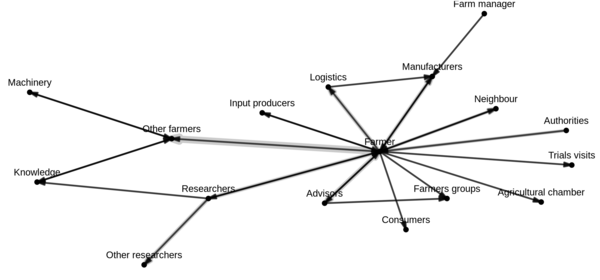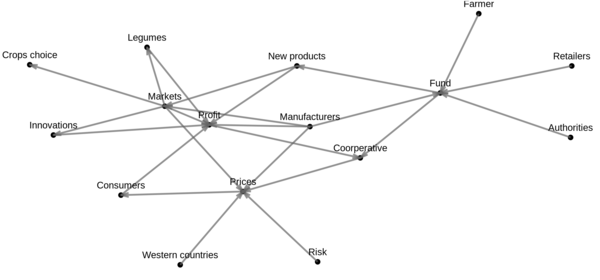Of the 128 experiences collected in the quantitative survey, 24 were selected for further qualitative analysis. Twelve partners from eleven countries were trained on qualitative survey methods and were responsible of two CDE each: one linked to agronomic innovation (e.g., intercropping and multiple cropping) and one linked to value-chain innovation (e.g., new crops and new products). For each CDE, local partners were asked to identify and select a diversity of key players from different levels of the value chain (farmers, manufacturers, etc.) to be qualitatively interviewed. We collected the 53 translated and transcribed interviews and analysed them using an approach based on qualitative coding and cognitive mapping (see figures 1 and 2).
Our study shows that crop diversification is taking place at different levels, within farms and throughout the value chain. As observed previously, barriers and lock-ins are slowing down its adoption. This echoes the results obtained by Morel et al. (2019) (available soon) on the barriers met in DiverIMPACTS case studies and Meynard et al. (2018) on crop diversification in France. We identified the lack of knowledge and references as main barriers to crop diversification at the farm level and logistics based on economies of scale and large volumes at the value chain level.
We observed that profit was often linked to the risk of failure of agronomic CDEs, referring to bad prices, new investments and market dynamics. For the CDEs taking place at the value chain level, risk linked to climatic and pest issues were the major factors of failure. In both cases, knowledge was also identified as a barrier.
Our analyses show that exchange of knowledge between farmers, researchers and advisors can benefit the expansion of crop diversification. This can take various forms such as individual exchanges, farmer groups or dissemination of information by researchers through publications, conferences and field days. Profitability is also an important concern at the farm and value chains levels, whether it is linked to input costs, investment or price of products. Authorities can act by implementing supportive policies and value chain players must support farmers by paying adequate prices and providing resources while also meeting consumer demand. Finally, researchers and advisors need to keep working on removing technical barriers and collaborating with farmers and value chain players to share knowledge in order to achieve crop diversification.
More detailed information about the results will be made available soon.




 tap and then scroll down to the Add to Home Screen command.
tap and then scroll down to the Add to Home Screen command.